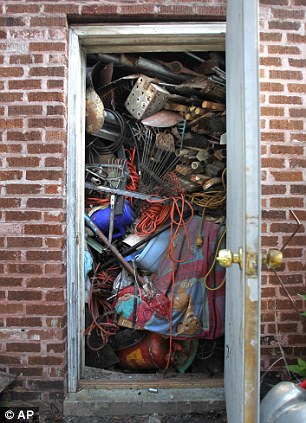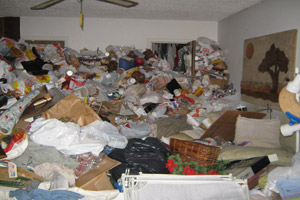Mental Mindsets: Packrats and Hoarders

You many have read the title and stopped to ask yourself – how is hoarding a mindset? Let me start by saying that a mindset can be simply described as a set mind. You have heard the sayings “a one track mind” or “being stuck in a rut”, which are both examples of a mental mindset. By the end of this article, you will have a better understanding of a person who is a packrat or a hoarder, and the mindsets that have made them that way.

The Beginning – Collections
Just about everyone has something they collect. Stamps, coins, dolls, sports memorabilia, model cars or trains. Many people have more than one type of collection going at the same time. People who become packrats or hoarders start out the same way as everyone else, with a few items that they are collecting. They will continue to collect items like a normal person until something triggers the change in their mental stability.

The Change – What Triggers it?
The most common trigger for a packrat or a hoarder is having to deal with a sudden loss of a loved one. Spouse, child, parent, or a close friend. Other triggers are having to move to a new town, leaving behind your friends and the life you knew, or having a close friend or family member move away, including having a child move away for college. This sudden loss triggers the need to fill the void with something that could be considered valuable. Often times, the sudden change in mental stability will include depression and obsessive compulsive disorders.
A room starts with a little clutter . . .


The Packrat
A packrat is still just a person who collects things. The big difference is the quantity of stuff collected. At first the packrat will have their collection out on display for everyone to see – look at all my beautiful stuff, I am a special person because I have all of this stuff. As the person puts more and more value into the items they collect, the collections start stacking up. While the packrat is eager to show off his or her stuff at first, they are less eager as it begins to pile up.
The person who was once so eager for company now starts making excuses for not inviting people over. The house is a little cluttered right now . . . I have been so busy that I haven’t had time to clean . . . I have something going on tonight, maybe some other time. Don’t get me wrong, I know that at some point in time everyone is going to have an excuse for not having company over. The difference is a packrat will continue doing this until they never allow anyone else into their house. The living room will have a path to the couch and chair amid the stacks of stuff.
As the collections continue to grow, it becomes harder to walk through the house. Often little pathways are made through a room to key points. An example of this is a bedroom that has a path to the bed and one to the closet area, but the rest of the room is piled up with collected items.

The Kitchen of a Hoarder

The Hoarder
The next step beyond being a packrat is being a hoarder. It is often difficult to tell the difference between a packrat and a hoarder. A hoarder is a packrat who has become overwhelmed by all of the collected items. Hoarders will hold onto clothes and toys from when their children were young in an effort to hold onto the good memories. Hoarders will also hang onto items that belonged to parents or other family members that have passed away. A hoarder has put some much value on the stuff they have collected that they refuse to throw anything away. The piles of stuff have now taken over the less used rooms in the house, to the point that there is no longer a path through the stuff. When feeling overwhelmed, the hoarder gives up on trying to clean the house. Most room are so packed with items that it is hard to tell what the room’s original purpose was. A bedroom? Den? Family room? It all looks the same when buried under years of stuff.
In the kitchen, you will find a large quantity of canned goods, usually years past the “best used by” date. The refrigerator will be crammed full of food that has spoiled but not been thrown away. Trash piles up along with the collected items. Newspapers and fast food containers become mixed in with the toys and clothes. Hoarders will often collect pets as well as other items, which adds feces and urine to the trash. The smell in the house becomes toxic, even for hoarders who do not have pets. Thick layers of dust, mold, grime, spider webs, and grease cover every surface.
This house fire was due to hoarding.

How to Help – Be Gentle
The outsider looking in will just see massive piles of junk and trash, but to a packrat or hoarder . . . it is all valuable collections. It is completely understandable for friends and family to want to help clean up the house of a packrat or hoarder. One of the key things to keep in mind is that a packrat or hoarder has to decide that they want help before they will let anyone help them. All of this stuff they have collected over the years means something to them and they don’t want someone to throw away any of their good stuff. Their mind is set with the assumption that without the stuff, their life has no value . . . without all of the pets, they are not needed. If you go into a packrat’s or hoarder’s home and start throwing away the stuff that you view as trash – the person will freak out, there will be yelling and screaming, possible even things being thrown at you.
The best way to approach a person who is a packrat or a hoarder is to ignore the stuff first. Pay attention to the person and show them that they are valuable, not the stuff. After weeks or even months of making sure the person feels valued for who they are, then you can touch on the subject of the stuff. Take baby steps . . . offer to help them pick up the old newspapers and food containers. Let the person know that they deserve better than living in all that stuff. I suggest starting in the kitchen, reminding the person of how wonderful it was to be able to cook a meal for the family and wouldn’t they like to be able to do that again . . . keep dropping little hints – do not come on to strong or the person will feel like they are being forced to give up their stuff.
If possible, get the packrat or hoarder to believe that it is their idea to clean up the house. Continue with the baby steps . . . offer to help sort the clothes from the toys. Put like items together. It will take a lot of self control on your part but you can help make a difference to the packrat or hoarder in your life.








